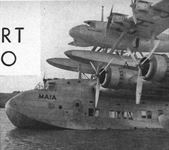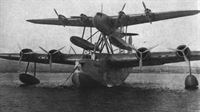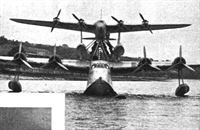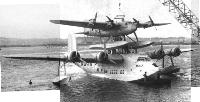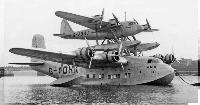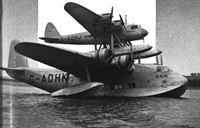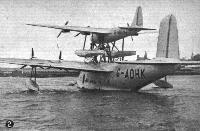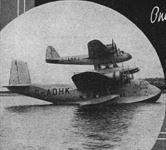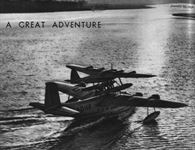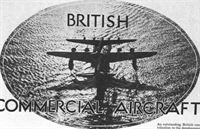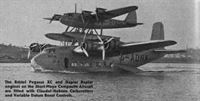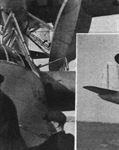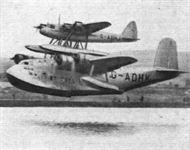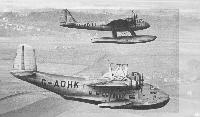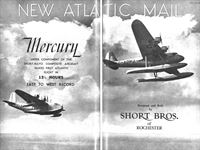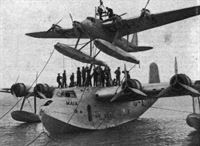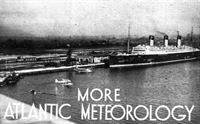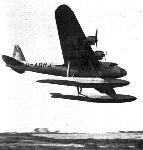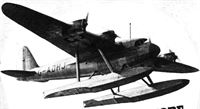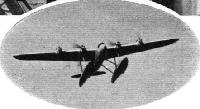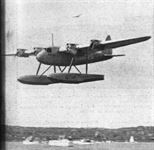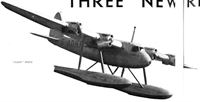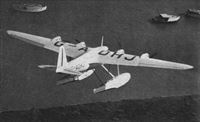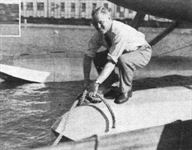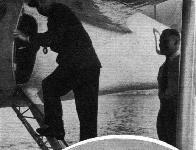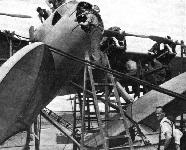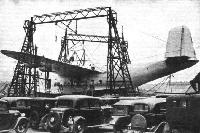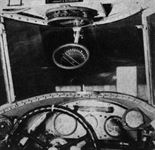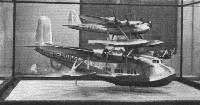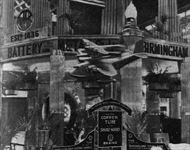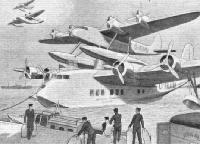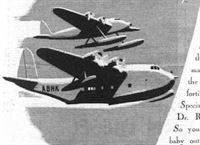
Варианты
- Short - Empire / S.23 - 1936 - Великобритания
- Short - Mayo Composite (S.20 Mercury and S.21 Maia) - 1938 - Великобритания
- Short - S.26 G-class - 1939 - Великобритания
Mayo Composite (S.20 Mercury and S.21 Maia)
Short S.20 и S.21 Mayo Composite
В результате проведенных авиакомпанией "Imperial Airways" испытаний было установлено, что летающая лодка Empire может достичь трансатлантической дальности полета только в том случае, если будет полностью загружена топливом. Однако специалисты знали, что самолет может совершать полет с большим весом, чем тот, с которым он может взлететь. Тогда майор Роберт Мэйо, генеральный технический менеджер "Imperial Airways", предложил выводить небольшой сильно перегруженный почтовый самолет на рабочую высоту на большой авиаматке, а затем освобождать его. Предложение было принято министерством авиации и "Imperial Airways", которые заключили контракт с компанией "Short Brothers" на проектирование и постройку такой составной конструкции.
Авиаматка S.21 Maia являлась слегка увеличенным и модифицированным вариантом летающей лодки Empire. Но самолет S.20 Mercury, который располагался над авиаматкой, являлся новым. Это был гидросамолет с высокорасположенным крылом и двумя поплавками, оснащенный четырьмя двигателями Napier Rapier H мощностью 340 л. с., которые обеспечивали крейсерскую дальность 6116 км с почтой массой 454 кг.
Первое разделение с авиаматкой в воздухе было выполнено 6 февраля 1938 года. После ряда экспериментальных полетов 21 июля самолет Mercury был запущен с авиаматки над городом Фойнс, Ирландия, и за 20 часов 20 минут совершил перелет протяженностью 4715 км в Монреаль, имея полезную нагрузку 272 кг.
6 октября 1938 года самолет Mercury стартовал над городом Данди, чтобы установить до сих пор непревзойденный международный рекорд дальности беспосадочного перелета для гидросамолетов в 9652 км, который он выполнил до реки Оранжевая в Южной Африке. Однако начало войны положило конец подобным экспериментам. Mercury разбился в Рочестере, a Maia был уничтожен немцами в мае 1941 года.
Описание:
- Mayo Composite (S.20 Mercury and S.21 Maia)
- Flight, February 1938
SHORT MAYO - Flight, November 1939
Britain's Civil Aircraft
Фотографии
-
Мировая Авиация 234
Регистрационный номер: G-ADHJ [98], G-ADHK [87] Short Mayo Composite появился в результате многочисленных попыток создать дальнюю трансатлантическую авиационную систему. Четырехмоторный Maia служил для вывода двухмоторного самолета Mercury на определенную высоту, где он взлетал и совершал дальнейший полет с большой полезной нагрузкой.
-
Jane's All the World Aircraft 1938 / 03 - All the world's aeroplanes
Регистрационный номер: G-ADHJ [98], G-ADHK [87] The Complete Mayo Composite Aircraft ready for its first test flight.
-
Flight 1938-02 / Flight
Регистрационный номер: G-ADHJ [98], G-ADHK [87] -
Flight 1938-02 / Flight
Регистрационный номер: G-ADHJ [98], G-ADHK [87] Picking up moorings after a flight. Mr. Lankester Parker is seen in the cabin of Maia, while Mr. Piper, who has had to scurry down from his perch in Mercury, is in the bow compartment making fast to one of the rubber buoys which are used exclusively at Rochester, and which were the invention of the late Mr. Eustace Short.
-
Aeroplane Monthly 1988-12 / A.Lumsden, T.Heffernan - Per Mare Probare (12)
Регистрационный номер: G-ADHJ [98], G-ADHK [87] Mercury and Maia at the MAEE at Felixstowe where they were each tested separately for a Certificate of Airworthiness. They were delivered there in March 1938, returning to Rochester in May.
-
Flight 1937-09 / Flight
Регистрационный номер: G-ADHJ [98], G-ADHK [87] EIGHT-ENGINED BIPLANE: This composite picture of the Short-Mayo gives an excellent idea of the relative sizes of the two components and of the appearance of the assembly as a whole before it is amoebically split into two. Mercury, the upper component, made flying trials early this week.
-
Flight 1939-06 / Flight
Регистрационный номер: G-ADHJ [98], G-ADHK [87] The Mayo composite, a useful experiment in long-range assisted take-off development.
-
АвиаМастер 2002-01 / И.Кудишин - "Самолет-звено" майора Майо /Раритеты/
Регистрационный номер: G-ADHJ [98], G-ADHK [87] -
Aeroplane Monthly 1988-12 / A.Lumsden, T.Heffernan - Per Mare Probare (12)
Регистрационный номер: G-ADHJ [98], G-ADHK [87] Mercury and Maia moored at Rochester in 1938. The Composite had first flown in January of that year, although its two component aircraft had made their first flights several months previously.
-
Мировая Авиация 124
Регистрационный номер: G-ADHJ [98], G-ADHK [87] "Меркьюри" с помощью подъемного крана устанавливают на фюзеляж "Майи".
Для обеспечения беспосадочных трансатлантических перелетов фирма "Short" по заказу авиакомпании "Imperial Airways" в конце 1930-х годов спроектировала своеобразный составной летательный аппарат Short-Mayo, состоящий из двух самолетов. С нижней лодки - авиаматки S.21, в воздухе стартовал поплавковый гидроплан S.20. Таким образом он не расходовал топливо на взлет и полет до точки расцепления. -
Авиация и Время 2019-04 / А.Хаустов - ... и не только
Регистрационный номер: G-ADHJ [98], G-ADHK [87] «Спарка» из самолетов S.21 «Майя» и S.20 «Меркури»
-
Flight 1938-02 / Flight
Регистрационный номер: G-ADHJ [98], G-ADHK [87] Maia and Mercury as a composite, or eight-engined, biplane.
-
Flight 1938-02 / Flight Advertisements
Регистрационный номер: G-ADHJ [98], G-ADHK [87] THE GREAT EXPERIMENT: This week Maia and Mercury, the two components of the Short composite aircraft, were brought together on the water for the first time. In this Flight photograph, taken last Tuesday, Mercury looks oddly small, although she is of 73 ft. span and 21,000 lb. gross weight.
-
Aviation Historian 11 / R.Pegram - Folland's Forgotten Monoplanes (3)
Регистрационный номер: G-ADHJ [98], G-ADHK [87] Связка Mercury-Maia. Технический советник "Imperial Airways", майор Р.Х. Майо, не считал возможным увеличение дальности полета и массы полезной нагрузки, если самолет такого класса не имеет даже возможности взлететь. Майо предложил концепцию связки, согласно которой большой самолет является носителем меньшего. Для проверки данной концепции министерство авиации заказало связку Mercury-Maia. Разработанный большой самолет (Maia) был очень похож на лодку "C"-класса, но отличался развитой надстройкой для крепления меньшего самолета. Меньший, Mercury, представлял собой высокоплан с четырьмя моторами Napier Rapier V мощностью по 340 л.с. После испытаний 21 августа 1938 года состоялся перелет через Атлантику из Фойнеса, Ирландия, в Монреаль. Mercury доставил 272 кг груза. Пилотировал Mercury австралиец Дон Беннет, позже ставший знаменитым летчиком британских ВВС. Второй перелет был выполнен также в 1938 году из Шотландии в Южную Африку. Начавшаяся война положила конец экспериментам.
"Maia-Mercury" (Mayo-Composite) 1938. This daring and revolutionary idea combined two aircraft, one being carried "pick-a-back" until released. The component Mercury still holds the world's long-distance seaplane record. The bottom component was a strengthened "Empire" Class flying-boat.
The Short Mayo Composite comprised the S.20 floatplane, registered G-ADHJ and named Mercury, and the lower S.21, G-ADHK, named Maia. The Composite proved itself over several long-distance flights during 1938, including a transatlantic crossing to Montreal and flights by the air-launched Mercury to South Africa and Egypt. -
Flight 1938-02 / Flight Advertisements
Регистрационный номер: G-ADHJ [98], G-ADHK [87] -
Flight 1939-01 / Flight
Регистрационный номер: G-ADHJ [98], G-ADHK [87] Practical experiments; the Mayo composite. During 1938 Mercury made a number of outstanding flights after taking off with the help of Maia
-
Flight 1938-01 / Flight
Регистрационный номер: G-ADHJ [98], G-ADHK [87] After minor modifications to details, the Mayo' Composite combination ("Maia" and "Mercury") has had its aerial baptism. On Wednesday of last week Capt. Lankester Parker had "Maia," with her burden, "on the step" and the first take-off, followed by a faultless ten-minute flight, was achieved on Thursday.
-
Flight 1937-12 / Flight
Регистрационный номер: G-ADHJ [98], G-ADHK [87] For the Mayo Composite machine the lower component was flight-tested and the upper receiving finishing touches.
-
Flight 1938-08 / Flight
Регистрационный номер: G-ADHJ [98], G-ADHK [87] ATLANTIC SPIRIT: The Shell tender at Foynes ministering to Mercury and Maia before the historic Atlantic flight.
-
Flight 1938-02 / Flight Advertisements
Регистрационный номер: G-ADHJ [98], G-ADHK [87] -
Flight 1940-12 / Flight
Регистрационный номер: G-ADHJ [98], G-ADHK [87] The Short-Mayo Composite. Mercury, the upper component, has four Rapiers, and Maia, the lower component, four Pegasus.
The composite aircraft taxying into position for a take-off with all eight engines running. -
Aeroplane Monthly 1988-12 / A.Lumsden, T.Heffernan - Per Mare Probare (12)
Регистрационный номер: G-ADHJ [98], G-ADHK [87] Evocative view of Mercury and Maia taken during the winter of 1937-38.
-
Flight 1938-01 / Flight
Регистрационный номер: G-ADHJ [98], G-ADHK [87] -
Flight 1938-04 / Flight
Регистрационный номер: G-ADHJ [98], G-ADHK [87] An outstanding British contribution to the development of commercial flying: the Mayo Composite aircraft.
-
Flight 1938-03 / Flight Advertisements
Регистрационный номер: G-ADHJ [98], G-ADHK [87] The Bristol Pegasus XC and Napier Rapier engines on the Short-Mayo Composite Aircraft are fitted with Claudel-Hobson Carburetters and Variable Datum Boost Controls.
-
Aeroplane Monthly 1988-12 / A.Lumsden, T.Heffernan - Per Mare Probare (12)
Регистрационный номер: G-ADHJ [98], G-ADHK [87] METACENTRIC HEIGHT: Out for its first taxying tests - the Short-Mayo Composite manoeuvring under its own power on the Medway last Monday. The extra-large out-board floats of the Maia are both in contact with the water, although the main hull does not seem to be unduly submerged.
-
Flight 1938-12 / Flight
Регистрационный номер: G-ADHJ [98] Loading mail into the floats of Mercury, upper component of the Short Mayo Composite, before she left Southampton on her 2,400-mile non-stop flight to Alexandria on Tuesday of last week, carrying over a ton of Christmas postal load.
-
Flight 1938-12 / Flight
Регистрационный номер: G-ADHJ [98], G-ADHK [87] "Mercury,'' in "Maia's" arms, being loaded with Christmas mails.
-
Flight 1938-02 / Flight
Регистрационный номер: G-ADHJ [98], G-ADHK [87] Getting ready for the great event. Mr. Piper goes on board Mercury, which is resting on the special supports on the Maia.
-
Aeroplane Monthly 1973-07 / C.Barnes - Transatlantic pick-a-back
Регистрационный номер: G-ADHJ [98], G-ADHK [87] -
Flight 1938-02 / Flight Advertisements
Регистрационный номер: G-ADHJ [98], G-ADHK [87] -
Flight 1938-12 / Flight
Регистрационный номер: G-ADHJ [98], G-ADHK [87] -
Flight 1938-10 / Flight
Регистрационный номер: G-ADHJ [98], G-ADHK [87] A breezy impression of the Short-Mayo composite aircraft taking off from the Tay.
-
Flight 1938-01 / Flight
Регистрационный номер: G-ADHJ [98], G-ADHK [87] TWO FIRSTS: The Short Mayo composite just free of the Medway on its first flight - Messrs. Lankester Parker and H. L. Piper in dual charge. This historically important first flight was followed by another, that of the Ensign, a few days later, at Hamble, Southampton.
-
Flight 1938-03 / Flight Advertisements
Регистрационный номер: G-ADHJ [98], G-ADHK [87] "A somewhat ‘dirty’ biplane" is the impression of the composite aircraft when flying, due mainly to the presence of the floats of the upper component.
-
Мировая Авиация 234
Регистрационный номер: G-ADHJ [98], G-ADHK [87] Композитная система Short-Mayo в составе самолетов S.20 Mercury (G-ADHJ) и S.21 Maia (G-ADHK) сфотографирована сразу после их разделения. 21 июля 1938 года Mercury отправился в рекордный полет в Монреаль, имея взлетную массу 9435 кг.
Short-Mayo Composite with (above) Mercury, holder of the record for distance in a straight line by a seaplane. -
Flight 1938-02 / Flight Advertisements
Регистрационный номер: G-ADHJ [98], G-ADHK [87] -
Flight 1938-04 / Flight Advertisements
Регистрационный номер: G-ADHJ [98], G-ADHK [87] -
Aeroplane Monthly 1974-05 / P.Moss - Wings for the Empire (5)
Регистрационный номер: G-ADHJ [98], G-ADHK [87] The Short-Mayo Composite team, Mercury and Maia, delivered to IAL in June 1938.
-
Aeroplane Monthly 1988-11 / A.Lumsden, T.Heffernan - Per Mare Probare (11)
Регистрационный номер: G-ADHJ [98], G-ADHK [87] UP WITH THE COMPOSITE: Though the first separation of the Short-Mayo composite combination, Mercury and Maia, is said to have been witnessed only by bargees in the Medway estuary, the art of the aerial photographer brings us an intimate glimpse of this strangest of all aircraft not long before the “great event.”
It is said that the first separation of the Short-Mayo composite combination, Mercury and Maia, was witnessed only by bargees in the Medway estuary. The photograph was taken not long before the great event. Note the Miles camera-plane in the distance.Другие самолёты на фотографии: Miles Falcon M.3 / Hawcon M.6 - Великобритания - 1934
-
Air Enthusiast 1992-12 / P.MacDougall - Medway Dynasty
Регистрационный номер: G-ADHJ [98], G-ADHK [87] Moment of separation of the Short-Mayo Composite.
-
Aeroplane Monthly 1984-10 / ??? - Guiding star. AVM D.C.T. Bennett CB CBE DSO
Регистрационный номер: G-ADHJ [98], G-ADHK [87] Mercury, piloted by D.C.T. Bennett, leaving Maia over Foynes on July 21, 1938 at the start of the non-stop flight to Montreal. This print was signed by A VM Bennett at the Royal Air Force Club during a meeting to discuss the Pathfinder Map project, on June 11 this year.
-
Flight 1938-07 / Flight
Регистрационный номер: G-ADHJ [98], G-ADHK [87] Short-Mayo Composite (21-22 July 1938).
-
Jane's All the World Aircraft 1938 / 03 - All the world's aeroplanes
Регистрационный номер: G-ADHJ [98], G-ADHK [87] A series of non-consecutive pictures taken from a cinematograph film showing the first publuc separation of the Mayo Composite Aircraft.
-
Flight 1938-03 / Flight
Регистрационный номер: G-ADHJ [98], G-ADHK [87] These extracts from the "British Movietone" slow-motion film of the separation tell the story vividly; especially do they show the steadiness of attitude in both units after separation. These pictures are not a continuous extract; they are selected from some eight feet of film.
-
Aeroplane Monthly 1973-07 / C.Barnes - Transatlantic pick-a-back
Регистрационный номер: G-ADHJ [98], G-ADHK [87] Frames taken from eight feet of British Movietone cine film made during the Press demonstration of February 23, 1938.
-
Aviation Historian 8 / F.Merriam - "Better to be Born Lucky than Rich..." /Echoes from Dawn Skies/ (3)
Регистрационный номер: G-ADHJ [98], G-ADHK [87] 6-8 октября 1938г.: Short S.20 Mercury, пилотируемый капитаном Д. Беннеттом, участвовал в попытке установления нового рекорда дальности для гидропланов. Взлетев с авиаматки S.21 Maia к северу от Данди, Mercury приземлился в Порт-Ноллоте (Южная Африка), преодолев без посадки 9651,90 км за 41 ч 56 мин.
On February 23, 1938, Lankester Parker was at the controls of Maia, the lower component of the Short Mayo Composite, for the second successful separation of the “pickaback” aircraft. Harold Piper was flying the upper component, Mercury. The idea showed some promise but the outbreak of war stymied its development. -
Flight 1938-10 / Flight
Регистрационный номер: G-ADHJ [98], G-ADHK [87] An impression of the actual separation a few miles north of Dundee. Major Mayo was an observer in the lower component.
-
Flight 1938-07 / Flight Advertisements
Регистрационный номер: G-ADHJ [98], G-ADHK [87] -
Flight 1938-05 / Flight
Регистрационный номер: G-ADHJ [98], G-ADHK [87] FULL-LOAD TRIALS: Twice last week the Short-Mayo composite made successful tests of separation with Mercury loaded to 20,800 lb. The trials took place off Felixstowe, and on the first occasion the machines were piloted by Short’s test pilots, Messrs. Parker and Piper. On the second they were flown by Sqn. Ldrs. Martin and Pickles, of the Marine Aircraft Experimental Establishment. With practically no wind, the take-offs were made in about 17 seconds. The picture shows Mercury being lifted by the Felixstowe crane. Maia can be seen afloat beyond the jetty.
-
Flight 1938-05 / Flight
Регистрационный номер: G-ADHJ [98], G-ADHK [87] Mercury, upper component of the Short Mayo Composite, being lowered on to Maia prior to a full-load separation
-
Aeroplane Monthly 1973-07 / C.Barnes - Transatlantic pick-a-back
Регистрационный номер: G-ADHJ [98], G-ADHK [87] Mercury being Lowered on to Maia during the official trials of May 1938.
-
Flight 1939-04 / Flight
Регистрационный номер: G-ADHJ [98], G-ADHK [87] Composition: Mercury being loaded on to Maia.
-
Air Enthusiast 1999-11 / V.Lesnitchenko - Combat Composites
Регистрационный номер: G-ADHJ [98], G-ADHK [87] R H Mayo patented a method of disengagement based upon a ‘separation force’ in 1932, this was turned into practicality by the well-known Short-Mayo Composite
-
Aeroplane Monthly 1988-11 / A.Lumsden, T.Heffernan - Per Mare Probare (11)
Регистрационный номер: G-ADHJ [98], G-ADHK [87] Mercury being lowered by crane into position on top of Maia. The combined empty weight of the composite was 34,000lb.
-
Aeroplane Monthly 1988-12 / A.Lumsden, T.Heffernan - Per Mare Probare (12)
Регистрационный номер: G-ADHJ [98], G-ADHK [87] Mercury and Maia at Dundee, where they were positioned for the abortive seaplane distance record attempt in October 1938.
-
Flight 1937-09 / Flight
Регистрационный номер: G-ADHJ [98], G-ADHK [87] "MAIA" MEETS "MERCURY": Following the tradition of "happy events," the lusty baby Mercury, upper component of the Short-Mayo Composite aircraft, was brought along to her mother-ship, Maia, last week.
-
Aeroplane Monthly 1973-07 / C.Barnes - Transatlantic pick-a-back
Регистрационный номер: G-ADHJ [98], G-ADHK [87] Positioned on the River Tay, Dundee, prior to the flight to Capetown.
-
Flight 1938-11 / Flight
Регистрационный номер: G-ADHJ [98], G-ADHK [87]
-
Flight 1937-09 / Flight
Регистрационный номер: G-ADHJ [98] -
АвиаМастер 2002-01 / И.Кудишин - "Самолет-звено" майора Майо /Раритеты/
Регистрационный номер: G-ADHJ [98] "Меркьюри" перед началом летных испытаний.
-
АвиаМастер 2002-01 / И.Кудишин - "Самолет-звено" майора Майо /Раритеты/
Регистрационный номер: G-ADHJ [98] "Меркьюри" на море и на суше.
-
Flight 1937-09 / Flight
Регистрационный номер: G-ADHJ [98] -
Flight 1937-09 / Flight
Регистрационный номер: G-ADHJ [98] The picture shows the very small frontal area. Note how little the Napier-Halford engines project.
-
Aeroplane Monthly 1988-11 / A.Lumsden, T.Heffernan - Per Mare Probare (11)
Регистрационный номер: G-ADHJ [98] Mercury as separate seaplane. The picture gives a good idea of the neat installation of the Napier-Halford Rapier engines
The Short S.21 G-ADHJ Mercury on the River Medway at Rochester in September 1937. It was launched on September 15 and test pilot John Parker made the maiden flight of 15min. The 73ft-span Mercury had an empty weight of 10,163lb and an all-up solo weight of 15,500lb. -
Flight 1937-10 / Flight
Регистрационный номер: G-ADHJ [98] Mercury, the upper component of the Short-Mayo effort, during trials on the Medway. This is a comparatively small machine of less than 1,200 h.p.
-
Jane's All the World Aircraft 1938 / 03 - All the world's aeroplanes
Регистрационный номер: G-ADHJ [98] The Upper Component of the Mayo Composite Aircraft (four Napier "Rapier V" engines).
-
Flight 1937-09 / Flight
Регистрационный номер: G-ADHJ [98] A perfect landing: Without trailing-edge flaps the speed is not excessive, even with the load carried when this picture was taken.
-
Flight 1937-09 / Flight
Регистрационный номер: G-ADHJ [98] In spite of its large floats, Mercury appears to have a top speed of considerably more than 200 m.p.h.
-
Flight 1938-07 / Flight Advertisements
Регистрационный номер: G-ADHJ [98] -
Flight 1937-09 / Flight
Регистрационный номер: G-ADHJ [98] The graceful lines are well brought out in the photograph of the machine flying overhead.
-
Flight 1938-02 / Flight
Регистрационный номер: G-ADHJ [98] After the successful separation Mr. Piper gave a fine demonstration of high-speed flying before alighting off the Short works at Rochester.
-
Flight 1938-03 / Flight Advertisements
Регистрационный номер: G-ADHJ [98] -
Flight 1938-07 / Flight Advertisements
Регистрационный номер: G-ADHJ [98] -
Flight 1938-04 / Flight
Регистрационный номер: G-ADHJ [98] Mercury, the shapely upper component of the Mayo Composite aircraft. This machine should make the transatlantic trip this year. The engines are four Napier Rapiers.
-
Aeroplane Monthly 1988-11 / A.Lumsden, T.Heffernan - Per Mare Probare (11)
Регистрационный номер: G-ADHJ [98] Pleasing view of Mercury flying low over the River Medway early in 1938. Its engines were air-cooled Napier-Halford Rapier engines of 340 h.p. apiece.
-
Aeroplane Monthly 1973-07 / C.Barnes - Transatlantic pick-a-back
Регистрационный номер: G-ADHJ [98] John Lankester Parker boarding Mercury.
-
Flight 1937-09 / Flight
Регистрационный номер: G-ADHJ [98] Just before Mercury's third flight: Mr. J. Lankester Parker going on board to give his demonstration. Mr. H. L. Piper, who will fly the machine during the next series of tests and during the actual separation, watches from his perch on one of the floats.
-
Aeroplane Monthly 1973-07 / C.Barnes - Transatlantic pick-a-back
Регистрационный номер: G-ADHJ [98] Mercury at Rochester a week before launching on September 5, 1937.
-
Flight 1937-09 / Flight
Регистрационный номер: G-ADHJ [98] -
Aeroplane Monthly 1989-01 / Skywriters
Регистрационный номер: G-ADHJ [98] Mercury under construction at Rochester in 1937.
-
Flight 1937-08 / Flight
Регистрационный номер: G-ADHJ [98] Mercury, the upper component, is nearing completion at Rochester and should be flying this month.
-
Flight 1937-08 / Flight
Регистрационный номер: G-ADHK [87] THE BETTER HALF - or, at least, the larger portion of the Short-Mayo composite. Basically an Empire boat, Maia has flared-out chines to give better stability on the water when carrying her seaplane, the inboard Pegasus engines are set farther out from the hull to clear the float plane's under-carriage and fixed-pitch airscrews, doubtless designed for efficiency at take-off are fitted.
-
Flight 1937-08 / Flight
Регистрационный номер: G-ADHK [87] In Home Waters: The lower component of the Short-Mayo composite aircraft, the Maia, on the Medway off Short's works. Note the supports for the upper component.
-
Aeroplane Monthly 1988-12 / A.Lumsden, T.Heffernan - Per Mare Probare (12)
Регистрационный номер: G-ADHK [87] Maia moored off Rochester in February 1938.
-
Flight 1938-10 / Flight Advertisements
Регистрационный номер: G-ADHK [87] -
Flight 1937-11 / Flight
Регистрационный номер: G-ADHK [87] The lower component of the Composite supports the upper on a trestle which incorporates the hook release gear.
-
Flight 1938-02 / Flight
Регистрационный номер: G-ADHK [87] Mr. Lankester Parker, who piloted Maia, inspects his “clocks” in the inset picture.
-
Aviation Historian 11 / R.Pegram - Folland's Forgotten Monoplanes (3)
Регистрационный номер: G-ADHK [87] Major Robert H. Mayo (right) alongside Short Bros test pilot John Lankester Parker, who, along with fellow test pilot Harold Piper, made the first successful in-flight separation of the sole Short Mayo Composite (the bottom half of which, G-ADHK, Maia, may be seen in the background) on February 6, 1938.
-
Aviation Historian 8 / F.Merriam - "Better to be Born Lucky than Rich..." /Echoes from Dawn Skies/ (3)
Регистрационный номер: G-ADHK [87] John Lankester Parker (furthest right) with Capt A.S. Wilcockson (centre) and Harold Piper, his colleagues during the trials of the Short Mayo Composite at Rochester in 1938. We have used Merriam’s own original title for Lankester Parker’s chapter - “Better To Be Born Lucky Than Rich” - luck always trumps money in the test-flying business!
-
Aeroplane Monthly 1988-11 / A.Lumsden, T.Heffernan - Per Mare Probare (11)
Регистрационный номер: G-ADHK [87] THE MASTER TOUCH. This view from above of Maia, the lower component of the Short-Mayo composite aircraft, shows how Mr. Lankester Parker puts down a large flying boat on the Medway. The occupants are scarcely aware of contact with the water.
This view of Short S.20 G-ADHK shows well the cradle on which Mercury sat during “piggy-back" flight. The 114ft-span S.21 was powered by four 920 h.p. Bristol Pegasus XC radial engines and had an all-up weight of 24,000lb (solo). -
Aeroplane Monthly 1988-11 / A.Lumsden, T.Heffernan - Per Mare Probare (11)
Регистрационный номер: G-ADHK [87] The Short S.20 G-ADHK Maia is seen returning to her base at Rochester on Sunday, February 6, 1938 following the first separation. The second separation was covered by British Movietone News and was made at a height of 700ft on February 23, 1938.
-
Flight 1937-08 / Flight
Регистрационный номер: G-ADHK [87] Piloted by Mr. Lankester Parker, the upper component of the Short Mayo Composite aircraft is now going through its flight tests.
-
Aeroplane Monthly 1988-11 / A.Lumsden, T.Heffernan - Per Mare Probare (11)
Регистрационный номер: G-ADHK [87] Крупный план ферменной трапеции, предназначенной для крепления "Меркьюри" на фюзеляже самолета-матки.
The cradle on which Mercury rested upon Maia in flight. Switches were incorporated at the upper ends of this central struts to indicate the trim of the aircraft. -
АвиаМастер 2002-01 / И.Кудишин - "Самолет-звено" майора Майо /Раритеты/
Регистрационный номер: G-ADHK [87] "Майю" выкатывают из сборочного цеха.
-
Flight 1937-07 / Flight
Регистрационный номер: G-ADHK [87] The lower component of the Short-Mayo composite aircraft being erected in the open at Rochester.
-
Flight 1937-09 / Flight Advertisements
The 1,200 Gallon "De Bergue" Riveted Wing Tank in course of construction for the "Mercury" (The Short-Mayo Upper Component).
-
АвиаМастер 2002-01 / И.Кудишин - "Самолет-звено" майора Майо /Раритеты/
Регистрационный номер: G-ADHK [87] Кабина "Майи" - сочетание комфорта, удобства и хорошего обзора.
-
Aeroplane Monthly 1988-11 / A.Lumsden, T.Heffernan - Per Mare Probare (11)
Регистрационный номер: G-ADHK [87] Maia’s cockpit. The indicating lights which showed the trim and pull of the upper component at any given moment may be seen in the roof.
-
Flight 1938-02 / Flight
Регистрационный номер: G-ADHK [87] The indicating lights which show the trim and pull of the upper component at any given moment.
-
Aeroplane Monthly 1989-01 / Skywriters
Регистрационный номер: G-ADHJ [98] Mr Webb’s photograph of Mercury’s cockpit.
-
Flight 1939-06 / Flight
Регистрационный номер: G-ADHJ [98] The roof-mounted P.4 compass in the Short-Mayo Mercury. For taking-off or landing the mirror shuts up flat against the compass-face and does not obstruct the pilot’s view.
-
Flight 1935-12 / Flight
Регистрационный номер: G-ADHJ [98], G-ADHK [87] IN MINIATURE : One of the many interesting exhibits at the Empire Airway Exhibition, which will be opened to-day, is this model of the Short-Mayo composite aeroplane.
-
Flight 1935-12 / Flight
Регистрационный номер: G-ADHJ [98], G-ADHK [87] The new "big stuff'' represented by models. The Short-Mayo composite machine.
-
Flight 1938-11 / Flight
Регистрационный номер: G-ADHJ [98], G-ADHK [87] The Short Mayo Composite lands at Heston! Otherwise a fine piece of model-making by Woodason Aircraft Models.
-
Flight 1937-07 / Flight
Регистрационный номер: G-ADHJ [98], G-ADHK [87] Heavier-than-air starting: A sectioned model of the Short-Mayo composite aircraft.
-
Flight 1939-02 / Flight Advertisements
Регистрационный номер: G-ADHJ [98], G-ADHK [87] A striking model of the Short-Mayo Composite illustrates the claim of the Birmingham Battery and Metal Co., Ltd., to have supplied all the copper tubing used in the two machines.
-
Flight 1935-11 / Flight
Регистрационный номер: G-ADHJ [98], G-ADHK [87] This drawing by G. H. Davis gives some idea of the manner in which the upper twin-float seaplane will be carried on the wing of the large flying boat in the Mayo scheme. The two machines take off locked together, virtually forming an eight-engined biplane. When the operational height has been reached, the securing catches are released, the upper unit proceeds on its way and the lower returns to its base.
-
Flight 1935-11 / Flight
Регистрационный номер: G-ADHJ [98], G-ADHK [87] The Short-Mayo "composite" aircraft consists of a large lightly flying boat which carries the long-range seaplane to the operational and then releases it.
-
Flight 1939-03 / Flight Advertisements
Регистрационный номер: G-ADHJ [98], G-ADHK [87] -
Aeroplane Monthly 1990-04
Регистрационный номер: G-ADHJ [98], G-ADHK [87] -
Flight 1938-02 / Flight Advertisements
Регистрационный номер: G-ADHJ [98], G-ADHK [87] -
Flight 1938-07 / Flight Advertisements
Регистрационный номер: G-ADHJ [98], G-ADHK [87] -
Flight 1938-07 / Flight Advertisements
Регистрационный номер: G-ADHJ [98] -
Jane's All the World Aircraft 1938 / 03 - All the world's aeroplanes
The Mayo Composite Aircraft.
-
Flight 1938-02 / Flight
How it is done: the interiors of the Short-Mayo units
-
Aviation Historian 11 / R.Pegram - Folland's Forgotten Monoplanes (3)
One of a number of illustrations accompanying Robert Mayo’s British patent for a composite aircraft, dated April 27, 1933. A patent was granted in the USA in July 1935, the document stating that it was for “a means for launching aircraft, the particular purpose... being to enable an aircraft to be launched at such speed and at such altitude as to ensure the safe continuation of its flight, without its first having to attain the necessary minimum flying speed by taxying over land or water”.
-
Flight 1938-02 / Flight
Structural details of Mercury are revealed by these Flight sketches. The central drawing shows the complete machine, with covering partly removed, and the lettered arrows give a clue to the locations of the structural features which are shown in greater detail in the other sketches.
Spar and rib construction is shown in A as well as in the large drawing at the top of the page. Extruded sections form the corners of the spar box, and the leading edge is built up as shown in B. Details of the tubular bracing of the spar box are illustrated in C, and the construction of the region where the wing joins the fuselage is revealed in D.
The large sketch also shows main constructional features of the fuselage of Mercury. It is built rather like a boat hull, and has a stout central keel, on which the weight of the machine is taken when it rests on the trestle on top of Maia’s wing. -
Flight 1938-12 / Flight
Somewhat similar to the construction of the Empire boat wing is that of the Short-Mayo Mercury. The fuel tank is in the form of a large tube which reinforces the wing, particularly in torsion.
-
Jane's All the World Aircraft 1938 / 03 - All the world's aeroplanes
The Mayo Composite Aircraft.
Тип фотографий
- Все фото (124)
- Боковые проекции (1)
- Ч/б фото (97)
- Кабина (7)
- Модели, рисунки, схемы, чертежи (19)


